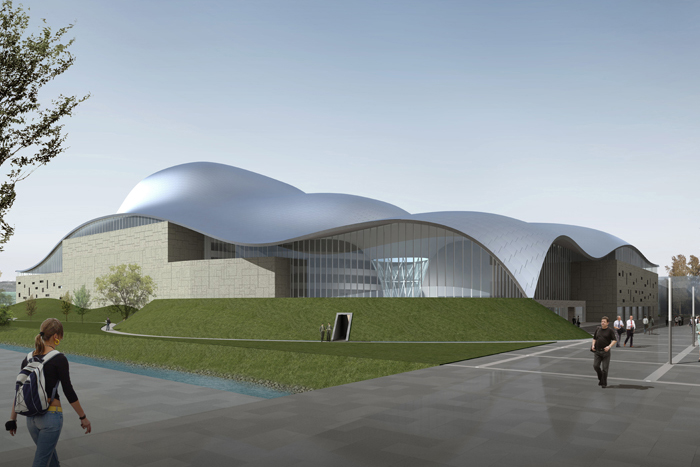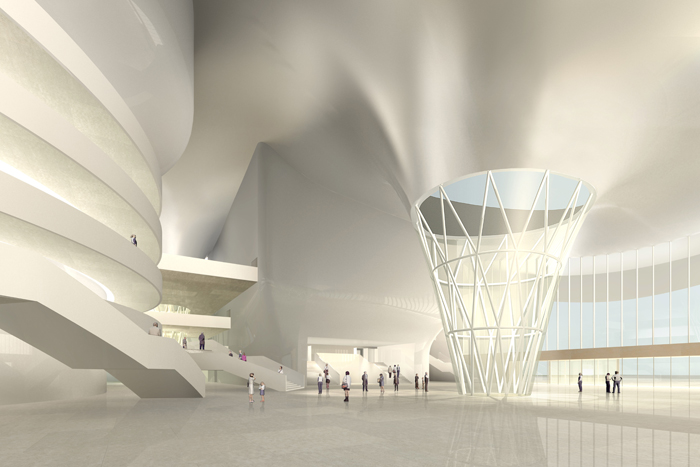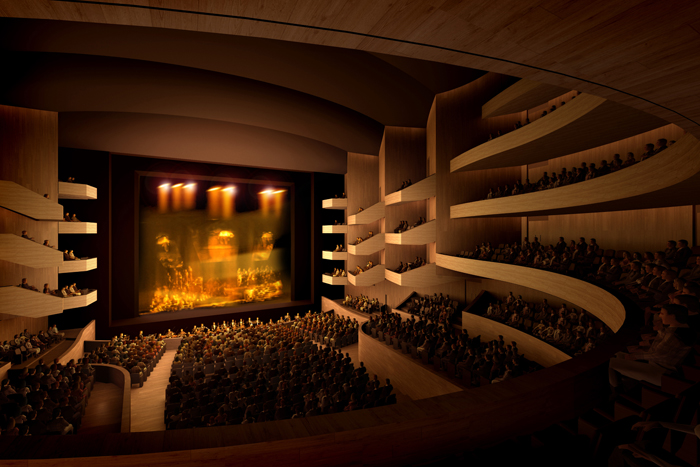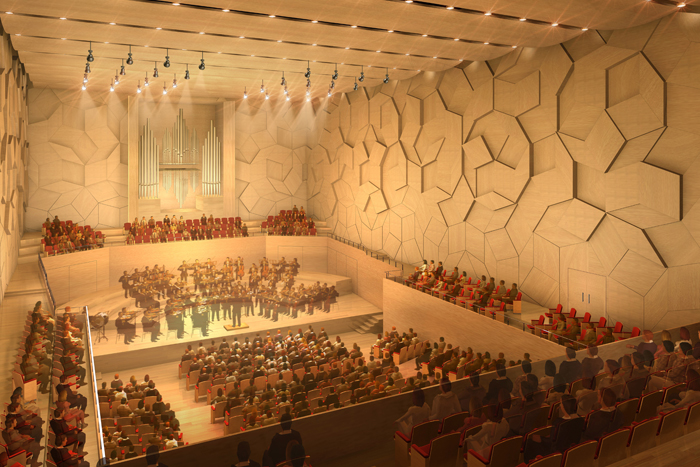



Music and Culture Park – Florence
project
New Florence Opera House
location
Florence
program
new opera house and concert hall
client
Presidenza del Consiglio dei Ministri, Missione per le Celebrazioni dei 150 anni dell’ Unità d’Italia
competition
2007
project
Arata Isozaki, Andrea Maffei
design team
Hidenari Arai, Takeshi Miura, Rawad Choubassi, Simone Utzeri, Filippo Biagi, Atsuko Suzuki
associate
Stefano Tozzi, M+T & Partners
structure
Arup Italia s.r.l.: Maurizio Teora, Giammichele Melis, Ida Coppola, Francesco Uggetti, Michele Mongelli, Riccardo Abello, Amerigo Tognarelli, Enrico Manganelli, Livio Quintavalle, Mario Rossato, Valeria Migliori, Matteo Testini, Floriana Palomba.
plants
Arup Italia s.r.l.: Pietro Guarisco, Alice Quinterio, Enrico Zara, Francesco Di Salvo, Katia Bernardi, Nicola Carofano, Sebastiano Genovese, Stefano Colombo.
geotechnic
Arup Italia s.r.l.- Angelo Mussi, Tim Hocombe, Francesco Petrella, Silvia Ferrero
acoustic
Nagata Acoustics, Tokyo, Japan – Yasuhisa Toyota, Satoru Ikeda Vie en Rose s.r.l. Firenze -Sergio Luzzi
fire consultant
ing. Silvestre Mistretta, Milano
general contractor
ATI – Baldassini Tognozzi Pontello Costruzioni Generali S.p.a., Mazzanti S.p.a., Opere Pubbliche e Ambiente S.p.a.
project
New Florence Opera House
location
Florence
program
new opera house and concert hall
client
Presidenza del Consiglio dei Ministri, Missione per le Celebrazioni dei 150 anni dell’ Unità d’Italia
competition
2007
project
Arata Isozaki, Andrea Maffei
design team
Hidenari Arai, Takeshi Miura, Rawad Choubassi, Simone Utzeri, Filippo Biagi, Atsuko Suzuki
associate
Stefano Tozzi, M+T & Partners
structure
Arup Italia s.r.l.: Maurizio Teora, Giammichele Melis, Ida Coppola, Francesco Uggetti, Michele Mongelli, Riccardo Abello, Amerigo Tognarelli, Enrico Manganelli, Livio Quintavalle, Mario Rossato, Valeria Migliori, Matteo Testini, Floriana Palomba.
plants
Arup Italia s.r.l.: Pietro Guarisco, Alice Quinterio, Enrico Zara, Francesco Di Salvo, Katia Bernardi, Nicola Carofano, Sebastiano Genovese, Stefano Colombo.
geotechnic
Arup Italia s.r.l.- Angelo Mussi, Tim Hocombe, Francesco Petrella, Silvia Ferrero
acoustic
Nagata Acoustics, Tokyo, Japan – Yasuhisa Toyota, Satoru Ikeda Vie en Rose s.r.l. Firenze -Sergio Luzzi
fire consultant
ing. Silvestre Mistretta, Milano
general contractor
ATI – Baldassini Tognozzi Pontello Costruzioni Generali S.p.a., Mazzanti S.p.a., Opere Pubbliche e Ambiente S.p.a.
currently no links
currently no links
currently no publications
currently no publications
Music and Culture Park – Florence
The project comes from the tender launched in October 2007 for the redevelopment of disused area outside the historic center of Florence, and in particular in the vicinity of the old rail-station Leopolda, and the Royal Park of the “Cascine”.
This work is part of those identified by the “Committee of Ministers for the 150th anniversary of the Unification of Italy” for the planning of infrastructure projects aimed at the realization and completion of major works of cultural and scientific interest for the whole country.
The theater was designed as a multi-functional complex to interact with a urban complex situation and find its proper place and configuration, confirming a full integration with the surrounding area to create a place open to the city and a real cultural center that all citizens could enjoy.
The design of a new cultural center allows the city to confirm and strengthen the vocation of cultural center in the opera and the music, in which Italy has a rich repertoire.
The project involves the construction of a 2000 seats hall for the opera, a 1,000 seats hall for concerts and an outdoor arena with 2000 seats for opera and concerts. The action is accompanied by external arrangements of the square in front and a small artificial hill that crowns the Arena.
We can depict the building as a set of interconnected volumes: three areas dedicated to those musical and theatrical performances, a volume that contains the services for dressing rooms, conductor and chorus, orchestra, singers and guest rooms test, offices, restrooms for actors and another volume with all the commercial space, excluding the bar placed on the ground and first floor facing directly on the foyer.
The foyer has the vocation of real square that is projected outside through the large windows that bring in direct connection with it.
The system volume described above is covered by an organic roof that covers the entire complex, like a skin lies over the internal volume. First of all the features were designed to their maximum efficiency and functionality, then the roof has unified through an organic form that gathers and transforms them into an architectural plastic system.
The new Auditorium has a square shape like shoe box, resulting from the best efficiency of acoustic performance.
The volumes contain spaces used for performances and other related activities such as dressing rooms, testing rooms, handling of the scenes, ticket office, wardrobe, dressing rooms, spaces and testing laboratories, service areas, technical areas, offices for administration, space for commercial activities related to the cultural complex, parking areas and parking are easy to spot from the outside.
The connective texture is reconstituted through a careful use of materials that take into consideration all aspects and requirements of contemporary without lack of respect for the best Florentine tradition. The walls as well as the pavement outside are covered by local “pietra serena” stone, to keep them in harmonious balance with the greatest monuments of the italian Renaissance.
Music and Culture Park – Florence
The project comes from the tender launched in October 2007 for the redevelopment of disused area outside the historic center of Florence, and in particular in the vicinity of the old rail-station Leopolda, and the Royal Park of the “Cascine”.
This work is part of those identified by the “Committee of Ministers for the 150th anniversary of the Unification of Italy” for the planning of infrastructure projects aimed at the realization and completion of major works of cultural and scientific interest for the whole country.
The theater was designed as a multi-functional complex to interact with a urban complex situation and find its proper place and configuration, confirming a full integration with the surrounding area to create a place open to the city and a real cultural center that all citizens could enjoy.
The design of a new cultural center allows the city to confirm and strengthen the vocation of cultural center in the opera and the music, in which Italy has a rich repertoire.
The project involves the construction of a 2000 seats hall for the opera, a 1,000 seats hall for concerts and an outdoor arena with 2000 seats for opera and concerts. The action is accompanied by external arrangements of the square in front and a small artificial hill that crowns the Arena.
We can depict the building as a set of interconnected volumes: three areas dedicated to those musical and theatrical performances, a volume that contains the services for dressing rooms, conductor and chorus, orchestra, singers and guest rooms test, offices, restrooms for actors and another volume with all the commercial space, excluding the bar placed on the ground and first floor facing directly on the foyer.
The foyer has the vocation of real square that is projected outside through the large windows that bring in direct connection with it.
The system volume described above is covered by an organic roof that covers the entire complex, like a skin lies over the internal volume. First of all the features were designed to their maximum efficiency and functionality, then the roof has unified through an organic form that gathers and transforms them into an architectural plastic system.
The new Auditorium has a square shape like shoe box, resulting from the best efficiency of acoustic performance.
The volumes contain spaces used for performances and other related activities such as dressing rooms, testing rooms, handling of the scenes, ticket office, wardrobe, dressing rooms, spaces and testing laboratories, service areas, technical areas, offices for administration, space for commercial activities related to the cultural complex, parking areas and parking are easy to spot from the outside.
The connective texture is reconstituted through a careful use of materials that take into consideration all aspects and requirements of contemporary without lack of respect for the best Florentine tradition. The walls as well as the pavement outside are covered by local “pietra serena” stone, to keep them in harmonious balance with the greatest monuments of the italian Renaissance.






